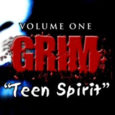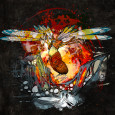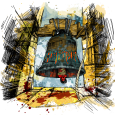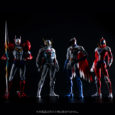Recently, I was asked to write an advance review for a forthcoming science fiction novel from a small press. I jumped at the opportunity to read the book before fully contemplating if it would be worth the time. Smaller presses are always a gamble in terms of quality, both with the writing and the printing, so for all I knew I was in for a terrible reading experience. I decided to plow through with the review anyway and soon found Leech Girl Lives by Rick Claypool and Spaceboy Books in my inbox. So, were my fears justified or was Leech Girl Lives worth the effort of a read through?
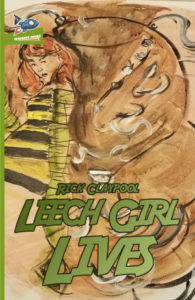 Leech Girl Lives takes place in a dystopian future where the majority of humanity has died out and what’s left live in a domed city called the Bublinaplex. While the Bublinaplex is surrounded by a “Fungus Wasteland” filled with large, horrendous and terrifying creatures, the people have managed to build a pretty stable world which is overly concerned with safety. This is where our protagonist comes in.
Leech Girl Lives takes place in a dystopian future where the majority of humanity has died out and what’s left live in a domed city called the Bublinaplex. While the Bublinaplex is surrounded by a “Fungus Wasteland” filled with large, horrendous and terrifying creatures, the people have managed to build a pretty stable world which is overly concerned with safety. This is where our protagonist comes in.
Margo Chicago is an Art Safety Inspector who investigates all works of art put on display to ensure that the artwork doesn’t hurt anyone. She has a fairly important job because the denizens of the Bublinaplex are all encouraged to work on some sort of “creative pursuit.” Some of these are worthwhile, like painting and singing while others, like Margo’s desire to crochet cats, are a little offbeat. Others still are just asinine, like Margo’s boss and his creativity in stringing nonsense words together in everyday conversations.
Due to a freak accident, Margo gets a pair of giant parasitic leeches attached to her arms. The leeches slowly eat away at her flesh and, through their symbiotic nature, become her new arms. It’s a unique concept. Although it sounded strange at first and had me questioning what kind of book I was reading, eventually the idea settled in and just flowed with the narrative. I wouldn’t have imagined that I’d enjoy a concept like that but I surely did.
Leech Girl Lives is author Rick Claypool’s first novel and that’s fairly evident in the way the book is written. Claypool builds his world and presents his novel using simple prose, which I liked. Lots of science fiction authors use long, flourishing prose and convoluted sentence structure that may sound pretty but can be confusing when trying to build an in-depth world. Claypool shirks that and just lays everything out on the table in easy bits for the layman. Whether this was intentional or just a byproduct of not finding his unique voice yet, I’m not entirely sure but the move worked in this instance.
One move that was intentional was the way Claypool split the chapters for the first third of the book. Each chapter vacillates between “Earlier” and “Later,” clearly delineating two different time periods. It’s an effective strategy that made the story more enticing; each time I finished one section, I wanted to find out what happened next but I had to read through a different section that piqued my interest just as much. Unfortunately, once the two sections converge, the story runs somewhat flat. It managed to remain interesting, but it lacked the oomph of the previous section.
The novel is also split into two distinct books, named Book One and Book Two. While I enjoyed Leech Girl Lives in its entirety, I did start to feel weighed down by the time I got to Book Two. It’s not that the second part wasn’t good; it’s just that I’d become burned out by the time I got there. I’d already gone through an entire adventure with Margo and her leech arms so to be thrown into another one right away was exhausting. I would have preferred if Leech Girl Lives ended at the first ending, with Book Two comprising an actual second book.
Doing so would have also allowed Claypool to expand on some of the themes he brings up in Book Two. While Book One dealt with the idea of stifling expression through the Art Safety’s mission to have artists alter any work they deem unsafe, Book Two explores the idea of a corporate run state as well as the division between the rich and the poor. By day, Rick Claypool is an activist who works with an organization that fights corporate power so if there would be anyone who can successfully integrate the dangers of a corporate state taking power in a silly little sci fi book, it’d be him. The way he breaks down the company’s rise to power makes us believe that the city would accept the corporate power, but everything that happens in Book Two happens so fast that it almost comes off as hokey despite the gravity of the theme. Claypool spends too much time focusing on scenes that don’t have much of an impact while breezing through others that are far more interesting. Characters speak in awkward, unnatural ways and the action doesn’t serve the plot but merely acts to hasten the transition to the next scene. I would have enjoyed it more if he slowed down and delved further into this new world he’s introduced. Allowed us to get to know a few of the newer characters better and see why they do what they do and how the corporation changed them from their previous lives.
The characterization is really the weakest part of Leech Girl Lives. Claypool focuses on Margo and spends a lot of time making sure she’s as fleshed out as possible, which is to be expected of the protagonist. Unfortunately he does this to the detriment of the supporting cast. Margo is surrounded by many unique and interesting people but they never feel whole. For example, Margo has a great relationship with her mentor, Cuthbert. Though we get a peak at Cuthbert’s home life, all we really know about him is he’s a great cook and he cries a lot. Even the book’s main protagonist, Lorcan Warhol, is a two-dimensional foil to Margo. Sure, his character takes an interesting twist during Book Two, but at a certain point he disappears and has no impact on the rest of the book. He had the makings of an interesting character but he’s flung off without a second thought.
I enjoyed Leech Girl Lives. The simple prose aside, the book played with some deep sociological themes and really dived into the darker aspects of society. Even the superficial nature of Margo’s affliction, forming a symbiotic relationship with a pair of parasitic leeches, was handled in a way that felt natural and believable. That’s not to say the book doesn’t have its flaws; in fact, there are quite a few of them, but they’re easily overshadowed by the depth of the symbolism. All in all, I’d recommend Leech Girl Lives if you’re looking for a fun adventure that doesn’t require too much brain power to really understand and enjoy.
Leech Girl Lives by Rick Claypool is available on September 26th from Spaceboy Books.
Grade: B-
So April may be Game of Thrones month here at Sub-Cultured for the upcoming season 5 premiere, but there was another important day this week that for the last few years has made the internet come alive in the name of comedy and foolishness.
That means shenanigans and hijinx. April Fool’s day, to be precise.
Every year a lot of companies in the nerd space assail us with pranks for new games or new products or just weird stuff in general – and with each passing year we’ve come to expect it. Google reversed everything with com.google and let you play Pac-Man in your Google maps. ThinkGeek advertised a Game of Thrones based edition of Clue taking place in Westeros, as well as a steam-powered Steam Box you could enjoy while drinking your Groot Beer. Microsoft went old school and “launched” MS-DOS Mobile for Lumia devices. And Blizzard, with their tried and true pranks, introduced the T.I.N.D.R. Box as an in-game item.
(Sorry kids, the link for Game of Thrones Clue was taken down. I’m hoping it’s because they’re going to MAKE IT REAL. You hear me, ThinkGeek? MAKE IT HAPPEN!)
But there was one trick I couldn’t figure out – and it was being played on me by Amazon. You see, they introduced Amazon Dash on April Fool’s day, a series of push-buttons you can affix anywhere in your home so that you will never (ever) run out of stuff. Stick a button marked “Tide” on your washer. Press the button when you need more. And more is bought for you. And delivered with Prime shipping. Check out the video below:
https://www.youtube.com/watch?t=0&v=NMacTuHPWFI
So clearly, this was just a joke, right? There’s no way I’m putting buttons all around my kitchen for Amazon shipment so I don’t have to go to the store to buy things, is there? Crap. I might. It’s possible highly probable that I’m just that lazy.
So I gave it a couple days and let it sink in. I figured maybe it would be a double cross and the reveal that it’s fake would be April 2nd. Or maybe they were bucking the trend and trying to hit me with a slow roll prank. Days passed and it didn’t go away. It just got more fleshed out. And it was then that it struck me – this is legit. I’ve signed up and I’m waiting for an invitation. Amazon Dash is part of their Amazon Fresh service, and you can sign up for it here. My address isn’t in the delivery area, but those April Fool’s buttons were just the start and I’m eagerly awaiting an expansion. If nothing else, I’ll have something to review for you kids, right? Now it looks like there’s a barcode scanner, with voice, that will scan and link anything you swipe with your Amazon Prime account, setting up an order. So in the wake of the confirmed legitness of Dash, to Amazon I have one thing to say:
You are absolutely brilliant.
From every aspect, Amazon is using the new “Internet of Things” craze to help people shop – and though these buttons are a bit weird, they might just save the day for people and families that are legitimately too busy. Doubly true for routine things we buy on a regular basis, like laundry detergent, coffee, and razors for shaving. What’s more is that big brands are getting in line to partner with them and be part of the program – after all, it’s their stuff we’re buying.
And how about debuting the program on April Fool’s day? If nothing else, they made Dash a household name within 24 hours of internet exposure – they made sure that regardless of whether we thought it was a prank or not that we at least knew the name. And whatever you truly believed, we were all scratching our heads on the 1st wondering if it was real.
So is this new IoT buying experience going to help streamline our busy lives, or is it taking us one step closer to what some would call our inevitable WALL-E future? I guess time will tell as Dash rolls out to more markets, and makes its way to a home near you. Here’s the latest from Amazon:
Tushar Nene
Staff Writer
@tusharnene



